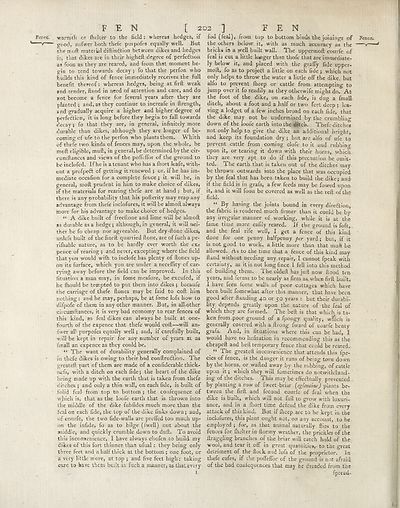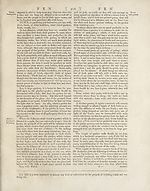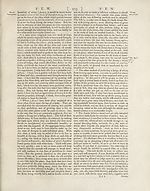Encyclopaedia Britannica > Volume 7, ETM-GOA
(224) Page 202
Download files
Complete book:
Individual page:
Thumbnail gallery: Grid view | List view

FEN [ 202 ] FEN
Fence, warmth or (belter to the field: whereas hedges, if
good, anfwer both thel'e puipofcs equally well. But
the moft mateiwl diftinftion between dikes and hedges
is, that dikes aie in their higheft degree of perfection
as foon as they are reared, and from that moment be¬
gin to tend towards decay; fo that the perfon who
builds this kind of fence immediately receives the full
benefit thereof: whereas hedges, being at firft weak
and tender, (land in need of attention and care, and do
rot become a fence for feveral years after they are
planted ; and, as they continue to increafe in ftrength,
snd gradually acquire a higher and higher degree of
perfetficn, it is long before they begin to fall towards
decay; fo that they are, in general, infinitely more
durable than dikes, although they are longer of be¬
coming of ufe to the perfon who plants them. Which
of thefe two kinds of fences may, upon the whole, be
moft eligible, mull, in general, be determined by the cir-
cumftances and views of the poffdfor of the ground to
be inclofed. If he is a tenant who has a (hort leafe, with¬
out a profpeft of getting it renewed ; or, if he has im¬
mediate occafion for a complete fence ; it will be, in
general, moft prudent in him to make choice of dikes,
if the materials for rearing thefe are at hand : but, if
there is any probability that his pofterity may reap any
advantage from thefe inclofures, it will be almoft always
more for his advantage to make choice of hedges.
“ A dike built of freeftone and lime will be almoft
as durable as a hedge; although, in general, it will nei¬
ther be fo cheap nor agreeable. But dry-ftone dikes,
unlefs built of the fineft quarried done, are of fuch a pe-
rifhable nature, as to be hardly ever worth the ex?
pence of rearing ; and never, excepting where the field
that you would wifh to inclofe has plenty of ftones up-f
on its furface, which you are under a neceflky of car¬
rying away before the field can be improved. In this
fituation a man may, in fome meafure, be excufed, if
he (hould be tempted to put them into dikes ; becauie
the carriage of thefe ftones may be faid to coft him
nothing : and he may, perhaps, be at fome lofs how to
dilpofe of them in any other manner. But, in all other
cii cumftances, it is very bad economy to rear fences of
this kind, as feal dikes can always be built at one-
fourth of the expence that thefe would coft—will an¬
fwer al! purpofes equally well; and, if carefully built,
will be kept in repair for any number of years at as
fmall an expence as they could be.
“ The want of durability generally complained of
in thefe dikes is owing to their bad conftruttion. The
greateft part of them are made of a confiderable thicks
ivefs, with a ditch on each fide; the heart of the dike
being made up with the earth that is taken from thefe
ditches ; and only a thin wall, on each fide, is built of
■ i’olid feal from top to bottom ; the confequence of
which is, that as the loofe earth that is thrown into
the middle of the dike fubfides much more than the
teal on each fide, the top of the dike finks down; and,
of courfe, the two fide-walls are preffed too much up¬
on the infide, fo as to bilge (1'well) out about the
middle, and quickly crumble down to duft. To avoid
this inconvenience, I have always chofen to build my
dikes of this fort thinner than ufual: they being only
three feet and a half thick at the bottom ; one foot, or
a very little more, at top ; and five feet high: taking
care to have them built in fuch a manner, as that every
fod (feal), from top to bottom binds the joinings of Fence;.
the others below it, with as much accuracy as the v—“
bricks in a well built wall. The uppermoft courfe of
feal is cut a little longer than thofe that are immediate¬
ly below it, and placed with the grafiy fide upper¬
moft, fo as to projetb a little on each fide; which not
only helps to throw the water a little off the dike, but
alfo to prevent (beep or cattle from attempting to
jump over it fo readily as they otherwife might do. At
the foot of the dike, on each fide, is dug a fmall
ditch, about a foot and a half or two feet deep ; lea¬
ving a ledget of a few inches broad on each fide, that
the dike may not be undermined by the crumbling
down of the loofe earth into the inch. Thefe ditches
not only help to give the dike an additional height,
and keep its foundation dry; but are alfo of ufe to
prevent cattle from coming clofe to it and rubbing
upon it, or tearing it down with their horns, which
they are very apt to do if this precaution be omit¬
ted. The earth that is taken out of the ditches may
be thrown outwards into the place that was occupied
by the feal that has beeu taken to build the dike; and
if the field is in grafs, a few feeds may be fowed upon
it, and it will foon be covered as well as the reft of the
field.
“ By having the joints bound in every direftion,
the fabric is rendered much firmer than it could be by
any irregular manner of working, while it is at the
fame time more eafily reared. If the ground is foft,
and the feal rife well, I get a fence of this kind
done for one penny halfpenny per yard ; but, if it
is not good, to work, a little more than that muft be
allowed. As to .the time that a fence of this kind may
(land without needing any repair, I cannot fpeak with
certainty, as it is not longfince I fell into this method
of building them. The oldeil has juil now flood ten
years, and feems to be nearly as firm as, when firft built.
1 have feen fome walls, of poor cottages which have
been built fomewhat after this manner, that have been
good after Handing 40 or 50 years : but their durabi¬
lity depends greatly upon the nature of the feal of
which they are formed. The heft is that which,is ta¬
ken from.poor ground of a fpongy quality, wfrich i&
generally covered with a ftrong fward of coarfe benty
grafs. And, in fituations where this can be had, I
would have no hefitation in recommending this as the
cheapeft and heft temporary fence that could be reared.
_ “ The greateft inconvenience that attends this fpe-
cies of fence, is the danger it runs of being torn down
by the horns, or wafted away by the rubbing, of cattle
upon it; which they will fometimes do notwithftand-
ing of the ditches. This may be effeatially prevented .
by planting a row of fweet-briar [eglantine) plants be¬
tween the firft and fecond courfe of feal when the
dike is built, which will not fail to grow with luxuri¬
ance, and in a (hort time defend the dike from every
attack of this kind. Bat if (beep, are to be kept in the
inclofures, this plant ought not, on any account, .to he
employed ; for, as that animal naturally flies to the
fences for (belter in ftormy weather, the prickles of the
ftraggling branches of the briar will catch hold of the
wool, and tear it .off in great quantities,- to the great
detriment of the flock and lofs of the proprietor. In
thefe cafes, if the poffeffor of the ground is not afraid
of the bad coniequences that may be dreaded from the
fpread-
Fence, warmth or (belter to the field: whereas hedges, if
good, anfwer both thel'e puipofcs equally well. But
the moft mateiwl diftinftion between dikes and hedges
is, that dikes aie in their higheft degree of perfection
as foon as they are reared, and from that moment be¬
gin to tend towards decay; fo that the perfon who
builds this kind of fence immediately receives the full
benefit thereof: whereas hedges, being at firft weak
and tender, (land in need of attention and care, and do
rot become a fence for feveral years after they are
planted ; and, as they continue to increafe in ftrength,
snd gradually acquire a higher and higher degree of
perfetficn, it is long before they begin to fall towards
decay; fo that they are, in general, infinitely more
durable than dikes, although they are longer of be¬
coming of ufe to the perfon who plants them. Which
of thefe two kinds of fences may, upon the whole, be
moft eligible, mull, in general, be determined by the cir-
cumftances and views of the poffdfor of the ground to
be inclofed. If he is a tenant who has a (hort leafe, with¬
out a profpeft of getting it renewed ; or, if he has im¬
mediate occafion for a complete fence ; it will be, in
general, moft prudent in him to make choice of dikes,
if the materials for rearing thefe are at hand : but, if
there is any probability that his pofterity may reap any
advantage from thefe inclofures, it will be almoft always
more for his advantage to make choice of hedges.
“ A dike built of freeftone and lime will be almoft
as durable as a hedge; although, in general, it will nei¬
ther be fo cheap nor agreeable. But dry-ftone dikes,
unlefs built of the fineft quarried done, are of fuch a pe-
rifhable nature, as to be hardly ever worth the ex?
pence of rearing ; and never, excepting where the field
that you would wifh to inclofe has plenty of ftones up-f
on its furface, which you are under a neceflky of car¬
rying away before the field can be improved. In this
fituation a man may, in fome meafure, be excufed, if
he (hould be tempted to put them into dikes ; becauie
the carriage of thefe ftones may be faid to coft him
nothing : and he may, perhaps, be at fome lofs how to
dilpofe of them in any other manner. But, in all other
cii cumftances, it is very bad economy to rear fences of
this kind, as feal dikes can always be built at one-
fourth of the expence that thefe would coft—will an¬
fwer al! purpofes equally well; and, if carefully built,
will be kept in repair for any number of years at as
fmall an expence as they could be.
“ The want of durability generally complained of
in thefe dikes is owing to their bad conftruttion. The
greateft part of them are made of a confiderable thicks
ivefs, with a ditch on each fide; the heart of the dike
being made up with the earth that is taken from thefe
ditches ; and only a thin wall, on each fide, is built of
■ i’olid feal from top to bottom ; the confequence of
which is, that as the loofe earth that is thrown into
the middle of the dike fubfides much more than the
teal on each fide, the top of the dike finks down; and,
of courfe, the two fide-walls are preffed too much up¬
on the infide, fo as to bilge (1'well) out about the
middle, and quickly crumble down to duft. To avoid
this inconvenience, I have always chofen to build my
dikes of this fort thinner than ufual: they being only
three feet and a half thick at the bottom ; one foot, or
a very little more, at top ; and five feet high: taking
care to have them built in fuch a manner, as that every
fod (feal), from top to bottom binds the joinings of Fence;.
the others below it, with as much accuracy as the v—“
bricks in a well built wall. The uppermoft courfe of
feal is cut a little longer than thofe that are immediate¬
ly below it, and placed with the grafiy fide upper¬
moft, fo as to projetb a little on each fide; which not
only helps to throw the water a little off the dike, but
alfo to prevent (beep or cattle from attempting to
jump over it fo readily as they otherwife might do. At
the foot of the dike, on each fide, is dug a fmall
ditch, about a foot and a half or two feet deep ; lea¬
ving a ledget of a few inches broad on each fide, that
the dike may not be undermined by the crumbling
down of the loofe earth into the inch. Thefe ditches
not only help to give the dike an additional height,
and keep its foundation dry; but are alfo of ufe to
prevent cattle from coming clofe to it and rubbing
upon it, or tearing it down with their horns, which
they are very apt to do if this precaution be omit¬
ted. The earth that is taken out of the ditches may
be thrown outwards into the place that was occupied
by the feal that has beeu taken to build the dike; and
if the field is in grafs, a few feeds may be fowed upon
it, and it will foon be covered as well as the reft of the
field.
“ By having the joints bound in every direftion,
the fabric is rendered much firmer than it could be by
any irregular manner of working, while it is at the
fame time more eafily reared. If the ground is foft,
and the feal rife well, I get a fence of this kind
done for one penny halfpenny per yard ; but, if it
is not good, to work, a little more than that muft be
allowed. As to .the time that a fence of this kind may
(land without needing any repair, I cannot fpeak with
certainty, as it is not longfince I fell into this method
of building them. The oldeil has juil now flood ten
years, and feems to be nearly as firm as, when firft built.
1 have feen fome walls, of poor cottages which have
been built fomewhat after this manner, that have been
good after Handing 40 or 50 years : but their durabi¬
lity depends greatly upon the nature of the feal of
which they are formed. The heft is that which,is ta¬
ken from.poor ground of a fpongy quality, wfrich i&
generally covered with a ftrong fward of coarfe benty
grafs. And, in fituations where this can be had, I
would have no hefitation in recommending this as the
cheapeft and heft temporary fence that could be reared.
_ “ The greateft inconvenience that attends this fpe-
cies of fence, is the danger it runs of being torn down
by the horns, or wafted away by the rubbing, of cattle
upon it; which they will fometimes do notwithftand-
ing of the ditches. This may be effeatially prevented .
by planting a row of fweet-briar [eglantine) plants be¬
tween the firft and fecond courfe of feal when the
dike is built, which will not fail to grow with luxuri¬
ance, and in a (hort time defend the dike from every
attack of this kind. Bat if (beep, are to be kept in the
inclofures, this plant ought not, on any account, .to he
employed ; for, as that animal naturally flies to the
fences for (belter in ftormy weather, the prickles of the
ftraggling branches of the briar will catch hold of the
wool, and tear it .off in great quantities,- to the great
detriment of the flock and lofs of the proprietor. In
thefe cafes, if the poffeffor of the ground is not afraid
of the bad coniequences that may be dreaded from the
fpread-
Set display mode to:
![]() Universal Viewer |
Universal Viewer | ![]() Mirador |
Large image | Transcription
Mirador |
Large image | Transcription
Images and transcriptions on this page, including medium image downloads, may be used under the Creative Commons Attribution 4.0 International Licence unless otherwise stated. ![]()
| Encyclopaedia Britannica > Encyclopaedia Britannica > Volume 7, ETM-GOA > (224) Page 202 |
|---|
| Permanent URL | https://digital.nls.uk/189124141 |
|---|
| Attribution and copyright: |
|
|---|
| Description | Ten editions of 'Encyclopaedia Britannica', issued from 1768-1903, in 231 volumes. Originally issued in 100 weekly parts (3 volumes) between 1768 and 1771 by publishers: Colin Macfarquhar and Andrew Bell (Edinburgh); editor: William Smellie: engraver: Andrew Bell. Expanded editions in the 19th century featured more volumes and contributions from leading experts in their fields. Managed and published in Edinburgh up to the 9th edition (25 volumes, from 1875-1889); the 10th edition (1902-1903) re-issued the 9th edition, with 11 supplementary volumes. |
|---|---|
| Additional NLS resources: |
|

